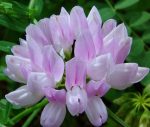 Also called purple vetch, this herbaceous perennial is a member of the pea family, Fabaceae, that also includes lupines, mimosa, and black locust. It is native to Europe, southwest Asia, and northern Africa but was introduced to North America in the 1950s and was used as a green manure and to control soil erosion along roadsides and waterways and on embankments. Since then it has spread and naturalized in the northeastern US where it can be found in a variety of sites such as fields, grasslands, prairies, roadsides, waste areas and natural areas. Creeping stems of the plants quickly form large clumps that can cover and shade out native vegetation, and crown vetch is considered invasive in Connecticut, Indiana, Kentucky, Maryland, Minnesota, Missouri, North Carolina, New Jersey, Oregon, Tennessee, Virginia, and Wisconsin. Crown vetch prefers full sun, dry to moist soil in USDA Hardiness Zones 3-7 and is intolerant of flooded soil or shade .
Also called purple vetch, this herbaceous perennial is a member of the pea family, Fabaceae, that also includes lupines, mimosa, and black locust. It is native to Europe, southwest Asia, and northern Africa but was introduced to North America in the 1950s and was used as a green manure and to control soil erosion along roadsides and waterways and on embankments. Since then it has spread and naturalized in the northeastern US where it can be found in a variety of sites such as fields, grasslands, prairies, roadsides, waste areas and natural areas. Creeping stems of the plants quickly form large clumps that can cover and shade out native vegetation, and crown vetch is considered invasive in Connecticut, Indiana, Kentucky, Maryland, Minnesota, Missouri, North Carolina, New Jersey, Oregon, Tennessee, Virginia, and Wisconsin. Crown vetch prefers full sun, dry to moist soil in USDA Hardiness Zones 3-7 and is intolerant of flooded soil or shade .
Description: Plants grow from a perennial crown and have long trailing branched stems that grow up 6′ long forming a 2′ tall mass. The dark green compound leaves are 2-4″ long and consist of 11 to 25 pairs of leaflets that are 1/2 to 3/4″ long. From late spring to late summer 1″ wide umbels of 5-20 pinkish flowers appear that are on long stalks and comprised of a single upper petal that is pink, and two side petals that are often white. The fruit is a long slender pods containing several long, smooth, brown seeds that are thought to be poisonous. Plants spread by seeds and rhizomes that can be 10′ long.
Control: Mechanical methods of control may be effective if all pieces of stem, root, and rhizomes are removed because even small pieces of these plant parts can generate new plants . Hand pulling and mowing can be successful for small infestations if repeated several times a year for several years and flowers are always removed before seeds mature. Large infestations may require the use of an herbicide such as glyphosate, triclopyr, and clopyralid and may require several applications.